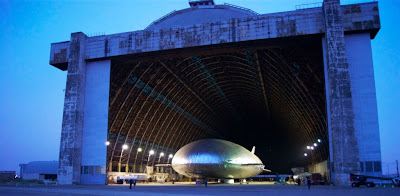Aeroscraft: The Airship of the Future
The first powered airship took to the skies on September 24, 1852, and the golden age of this type of aircraft ended with the tragic Hindenburg disaster on May 6, 1937. These days, we mostly see airships in the form of floating billboards. However, some have refused to let go of the notion that airships may have an important role to play in the future of air travel. Science fiction authors and filmmakers often feature reinvented takes on airships. And as it turns out, they could be onto something.
Manufactured by Montebello, California-based American aircraft company the Worldwide Aeros Corporation, the Aeroscraft is a far cry from the blimps of the past. From its rigid structure to its control of static heaviness (COSH) system, it’s a modern aircraft that incorporates many cutting edge and ground-breaking technologies. The first functioning prototype, a more basic model known as The Pelican, was successfully floated on January 3, 2013 in Tustin, California. The Pelican was created thanks to funding from the United States Department of Defense.
The Aeroscraft has a rigid structure that is composed of extremely light aluminium and carbon fibre materials, and it’s this that makes it unique among airships. The frame, which gives the airship its shape, is made up of partitions connected to horizontally running beams. Engines, propulsion systems and canards can all be securely mounted to this structure, inside and outside of the hull.
One of the main advantages of an airship over an airplane is its ability to lift off and land without a runway. Like the vast majority of modern airships, the Aeroscraft uses helium for lift. Employing COSH technology, the gas is internally ballasted into helium pressure envelopes, or HPEs. These HPE units regulate the compressed helium, increasing or decreasing the overall envelope volume, which makes the craft either lighter or heavier.
As mentioned, the Aeroscraft, like a helicopter, does not require a runway. Its vertical take-off and landing (VTOL) is made possible by the use of six turbofan jet engines. Once the airship reaches its cruising altitude, its aerodynamic shape helps to keep it airborne by generating lift, while large propellers on its rear section move it forward.
Not only does the Aeroscraft take off and land with ease; it doesn’t even need to land to load and unload its cargo. Whether it’s on the ground or still hovering, the craft can use its proprietary ceiling suspension cargo deployment (CSCD) system to accommodate easy loading and unloading. And because of its COSH system, there is no need for extra rigging or ballasting to hold the ship down during the operation.
With a cruising speed of up to 151 knots, the Aeroscraft was definitely not designed for speed, at least compared to commercial passenger planes. However, it compensates for this by having an enormous cargo hold. The ML866 model will boast a space that is 220 feet long, 40 feet wide and 40 feet high. And the planned ML868 model will offer an incredible cargo space that is 380 feet long, 61 feet wide and 45 feet high. On future purpose-built cargo ships, there will be enough room for entire warehouses’ worth of goods - in fact, even a complete oil rig.
With its VTOL and cargo carrying capabilities, the Aeroscraft is of great interest to the military. Whole platoons, along with their gear, weapons and supplies, could be airlifted into battle zones in one trip. The airships would also be very effective when it comes to disaster relief - lifting in vital water, food and medicines, and evacuating people from places regular airplanes are unable to reach. They could even be used to douse wildfires with over 66 tons of water at a time.
More commercial uses for the airships include flying equipment for oil and gas exploration into isolated areas and carrying large wind turbines to their sites. Within the travel industry, the Aeroscraft fleet could operate like giant floating cruise ships in the sky, offering spectacular views in a luxurious environment. The very rich could even buy an Aeroscraft of their own - an unusual alternative to more traditional status symbols like yachts.
The first Aeroscraft is expected to hit the skies by 2016, with a fleet of 24 ready by around 2020. Bill Feeley, Aeros’ director of strategic finances, told CNN, “This truly is a game-changer. It’s a real shift in industrial technology, on a par with the building of skyscrapers, or the creation of nuclear energy.” Perhaps one day soon the era of majestic airships might come again.











Comments
Post a Comment